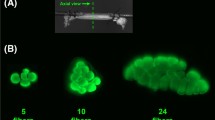Summary
The macroanatomy of the clinically important lumbar muscles has recently been investigated in detail, whereas the information about their microscopic structure in healthy persons is still scanty. In this study we have analysed lumbar multifidus and erector spinae muscles from 21 previously healthy persons who died suddenly and were of working age (range 23–65 years, mean 44.7 years). The microscopic structure of myofibers within the lumbar muscles was found to be regionally uniform, which renders in vivo biopsies representative of the whole muscle bulk. Somewhat surprisingly, age did not significantly influence fiber type composition, fiber size, or proportion of nonmuscular tissue. There was a slight predominance of type 1 fibers. The size of type 1 fibers (mean lesser diameter 54.0 μm) corresponded to that in other skeletal muscles, with no significant sex difference (55.1/51.6 μm male/female). Selective type 2 fiber atrophy was a common finding in both sexes, but significantly less so in men (mean diameter 38.8/28.4 μm male/female). We suggest that the values of fiber type proportions and fiber size in the deep multifidus presented in this study can be used as reference values for healthy adults in the present society with limited physical activity.
Similar content being viewed by others
References
Bogduk N (1980) A reappraisal of the anatomy of the human erector spinae. J Anat 131:525–540
Dubowitz V (1985) Muscle biopsy: a practical approach, 2nd edn. Balliere Tindall, London
Ford D, Bagnall KM, McFadden KD, Greenhill B, Raso J (1983) Analysis of vertebral muscle obtained during surgery for correction of a lumbar disc disorder. Acta Anat (Basel) 116:152–157
Henriksson KG (1979) ‘Semin-open’ muscle biopsy technique: a simple outpatient procedure. Acta Neurol Scand 59:317–323
Jennekens FGI, Tomlinson BE, Walton JN (1971) Data on the distribution of fibre types in five human limb muscles. J Neurol Sci 14:245–257
Johnson MA, Polgar J, Weightman D, Appleton D (1973) Data on the distribution of fibre types in thirty-six human muscles. An autopsy study. J Neurol Sci 18:111–129
Kalimo H, Rantanen J, Viljanen T, Einola S (1989) Lumbar muscles: anatomy and function (a review). Ann Med 21:353–359
Lexell J, Downham D (1992) What is the effect of ageing on type 2 muscle fibers. J Neurol Sci 107:250–251
Lexell J, Henriksson-Larsen K, Winblad B, Sjöström M (1983) Distribution of different fiber types in human skeletal muscle: effects of aging studied in whole muscle cross sections Muscle Nerve 6:588–595
Macintosh JE, Bogduk N (1987) The morphology of the lumbar erector spinae. Spine 12:658–668
Macintosh JE, Valencia F, Bogduk N, Munro RR (1986) The morphology of the human lumbar multifidus. Clin Biomech 1 205–213
Mattila M, Hurme M, Alaranta H et al (1986) The multifidus muscle in patients with lumbar disc herniation. Spine 11: 732–738
Moore MJ, Rebeiz JJ, Holden H, Adams RD (1971) Biometric analysis of normal skeletal muscle. Acta Neuropathol (Berl) 19:51–69
Polgar J, Johnson MA, Weightman D, Appleton D (1973) Data on fibre size in thirty-six human muscles. An autopsy study. J Neurol Sci 19:307–318
Rantanen J, Hurme M, Falck B et al. (1993) The lumbar multifidus muscle five years after operation for a lumbar intervertebral disc herniation. Spine 18:568–574
Shorey CD, Cleland KW (1983) Problems associated with the morphometric measurement of transverse muscle fibers. 1. Analysis of frozen sections. Anat Rec 207:523–531
Shorey CD, Cleland KW (1988) Morphometric analysis of frozen transverse sections of human skeletal muscle taken post-mortem. Acta Anat 131:30–34
Song SK, Shimada N, Anderson PJ (1963) Orthogonal diameters in the analysis of muscle fibre size and form. Nature 200:1220–1221
Susheela AK, Walton JN (1969) Note on the distribution of histochemical fibre types in some normal human muscles. A study on autopsy material. J Neurol Sci 8:201–207
Thorstensson A, Carlsson H (1987) Fibre types in human lumbar back muscles. Acta Physiol Scand 131:195–202
Zhu XZ, Parniapour M, Nordin M, Kahanovitz N (1989) Histochemistry and morphology of erector spinae muscle in lumbar disc herniation. Spine 14:391–397
Author information
Authors and Affiliations
Rights and permissions
About this article
Cite this article
Rantanen, J., Rissanen, A. & Kalimo, H. Lumbar muscle fiber size and type distribution in normal subjects. Eur Spine J 3, 331–335 (1994). https://doi.org/10.1007/BF02200146
Issue Date:
DOI: https://doi.org/10.1007/BF02200146




